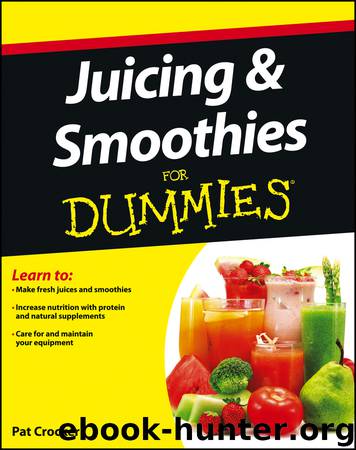Juicing and Smoothies For Dummies by Pat Crocker

Author:Pat Crocker
Language: eng
Format: epub, mobi, azw3, pdf
Publisher: Wiley
Published: 2012-11-13T16:00:00+00:00
Orange/yellow
Alpha- and beta-carotene, lutein, and lycopene are the biological pigments that give orange/yellow fruits and vegetables their color. Studies show that orange/yellow plant foods protect against cancer and stroke. Eating one or two every day will guard against heart disease, cancer, and other modern ailments.
Here are some great examples of orange/yellow fruits and vegetables you can juice:
Apricots
Bell peppers
Cantaloupe
Carrots
Grapefruit
Lemons
Mangoes
Nectarines
Oranges
Papayas
Peaches
Pineapple
Plums
Pumpkin
Squash
Sweet potatoes
Tangerines
Yams
Red
Seven of the top 20 antioxidant fruits and vegetables are red. Anthocyanins (the bright red, purple, and blue pigments found in plants), cancer-fighting ellagic acid, and vitamin C, among other things, are high in this color group. Just like the heat and emotion they represent, red fruits and vegetables are essential to the daily diet, so plan to include one or two of these balls of fire in your daily juice or smoothie regimen.
Here are some examples of red fruits and vegetables you can juice:
Apples
Beets
Bell peppers
Cherries
Cranberries
Plums
Pomegranates
Raspberries
Red onions
Grapes
Strawberries
Tomatoes
Blue/purple
Bright blue/purple vegetables get their pigment from anthocyanins and beta-carotene, both excellent cancer-fighters. Aim to include one blue-purple fruit or vegetable every day.
Here are some examples of blue/purple fruits and vegetables you can juice:
Bilberries
Blackberries
Blueberries
Concord grapes
Eggplants
Elderberries
Purple carrots
Purple potatoes
Purple tomatoes
Green
Chlorophyll is the pigment that gives green fruits and vegetables their color. Green foods are good sources of carotenoids (vitamin A precursors), including lutein and powerful antioxidants. Green vegetables tend to score lower on the glycemic index chart (see Chapter 5 for more on the glycemic index), so they’re a good balancing addition to juices.
Juice the following green vegetables in small amounts once you’re enjoying a wide variety of new vegetables:
Asparagus
Bell peppers
Broccoli
Brussels sprouts
Cabbage
Collard greens
Kale
Musk melon
Mustard greens
Spinach
Swiss chard
Dark green vegetables are powerful laxatives. Start with a ratio of one dark green vegetable to four to six other vegetables, and don’t introduce dark green vegetables until you’ve enjoyed a wide variety of new vegetable colors and tastes because they’re strong and potent.
Green grasses, herbs, and sprouts
Cereal grasses (from barley, rye, buckwheat, and wheat) and sprouts (from beans and lentils) are nutrition powerhouses because they contain all the nutrients necessary for growing the mature plant. Wild weeds and cultivated herbs offer a wide range of vitamins, minerals, and phytonutrients, with chlorophyll as an added bonus. Use them fresh, or whisk powdered greens (available at natural food stores) into juices.
If you’re interested in growing your own grasses and herbs and sprouting your own seeds so that the nutrients are at their peak when you juice them, check out Container Gardening For Dummies, 2nd Edition, by Bill Marken, Suzanne DeJohn, and the Editors of the National Gardening Association (Wiley).
Not every juicing machine can efficiently extract juice from grasses, herbs, and sprouts, so if you’re buying a juicing machine, look for one that can handle these delicate sprigs. If you already own a good juicer
Download
Juicing and Smoothies For Dummies by Pat Crocker.mobi
Juicing and Smoothies For Dummies by Pat Crocker.azw3
Juicing and Smoothies For Dummies by Pat Crocker.pdf
This site does not store any files on its server. We only index and link to content provided by other sites. Please contact the content providers to delete copyright contents if any and email us, we'll remove relevant links or contents immediately.
| Blenders | Bread Machines |
| Cast Iron | Dehydrators |
| Dutch Ovens | Fondue Pots |
| Food Processors | Fryers |
| Frozen Desserts | Juicers |
| Pressure Cookers | Rice Cookers |
| Slow Cookers | Woks |
Betty Crocker's Good and Easy Cook Book by Betty Crocker(2679)
Food and Water in an Emergency by Food & Water In An Emergency(2339)
Easy Rice Recipes: Learn New Creative Styles Like Spanish, Asian, Oven Baked, Bowls, and Much More by Press BookSumo(2242)
The Art of Making Gelato by Morgan Morano(2216)
Vegan Desserts by Hannah Kaminsky(2032)
Better Homes and Gardens: Wonder Pot by Better Homes & Gardens(2030)
The I Quit Sugar Cookbook by Sarah Wilson(2001)
Project Smoke by Steven Raichlen(1997)
2250 Pressure Cooker, Crock Pot, Instant Pot and Slow Cooking Recipes Cookbook: (Crock-Pot Meals, Instant Pot Cookbook, Slow Cooker, Pressure Cooker Recipes, Slow Cooking, Paleo, Vegan, Healthy) by Jamie Stewart(1952)
Smoke & Spice by Cheryl Alters Jamison(1883)
The Air Fryer Bible by Susan LaBorde & Elizabeth Hickman(1855)
Food Processor Perfection by America's Test Kitchen(1825)
Every Grain of Rice: Simple Chinese Home Cooking by Fuchsia Dunlop(1783)
The Jam and Marmalade Bible by Jan Hedh(1616)
Slow Cooking for Two: A Slow Cooker Cookbook with 101 Slow Cooker Recipes Designed for Two People by Mendocino Press(1612)
Sweetly Raw Desserts: Raw Vegan Chocolates, Cakes, Cookies, Ice Cream, and More by Heather Pace(1585)
The French Baker by Sébastien Boudet(1579)
The Wood Pellet Smoker and Grill Cookbook by Peter Jautaikis(1551)
Idiot's Guides - Pressure Cooking by Tom Hirschfeld(1530)
